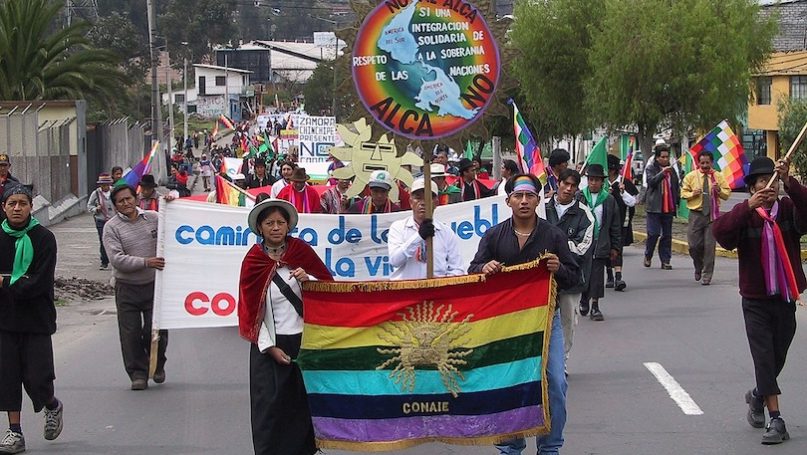
This case study is an excerpt from McGlinchey, Stephen. 2022. Foundations of International Relations (London: Bloomsbury).
In 1990, indigenous peoples in Ecuador blocked access to highways across the country – part of a nonviolent demonstration designed to raise awareness of injustices and discriminations that indigenous people had suffered, especially with regards to land reform. The uprisings began just before the June solstice and were subsequently called the Inti Raymi – Festival of the Sun. During the uprising, the Confederación de Nacionalidades Indígenas del Ecuador (CONAIE), founded in 1986 as a representative body for all indigenous peoples in Ecuador, presented a set of demands concerning indigenous control over indigenous affairs across a range of economic, political and cultural issues. Most importantly, CONAIE demanded that the Constitution recognise the ‘plurinational’ character of Ecuador.
This was a significant challenge to the norm of state sovereignty. Recall that the Treaty of Westphalia was supposed to have established the principle of non-intervention. Many International Relations scholars build on this principle, oftentimes presenting state sovereignty as an indivisible quality: to be sovereign is to exercise sole political rule over a territory, including representing the polity on the world stage (via diplomacy). Any qualification to this rule and representation is an abrogation of sovereignty. Indigenous peoples do not necessarily challenge the integrity of state sovereignty if their presence is legislated in terms of a minority group. But to legally present your group as a self-determining nation, within a state, and even more so, living side by side with other indigenous nations certainly does challenge state sovereignty to its core. This is the depth of political transformation that CONAIE sought.
In June 1990, just one month after the uprising, CONAIE, along with the Organización Nacional Indígena de Colombia (ONIC) and the South American Indian Information Center (SAIIC), organised the First Continental Conference on Five Hundred Years of Indigenous Resistance. Representatives from one 120 indigenous nationalities and organizations spanning the Americas attended, demanding meaningful self-government. The Conference also sought to pre-empt and critique celebrations that were to accompany the 500th anniversary of Columbus’s landfall in the Bahamas. Attendees formed a set of commissions that discussed the anniversary, human rights, self-determination, land claims and the role of women. The result of the conference was a Declaration of Quito, Ecuador, which claimed the following:
The Indios of America have never abandoned our constant struggle against the conditions of oppression, discrimination and exploitation which were imposed upon us as a result of the European invasion of our ancestral territories … We must guarantee the necessary conditions that permit complete exercise of our self-determination; and this, in turn must be expressed as complete autonomy for our Peoples. Without Indian self-government and without control of our territories, there can be no autonomy … The achievement of this objective is a principal task for Indian Peoples however, through our struggles we have learned that our problems are not different, in many respects, from those of other popular sectors. We are convinced that we must march alongside the peasants, the workers, the marginalized sectors, together with intellectuals committed to our cause, In order to destroy the dominant system of oppression and construct a new society, pluralistic, democratic and humane, in which peace Is guaranteed (Declaration of Quito, Ecuador, July 1990 1991).
In many ways the declaration can be considered an international rather than domestic document. Recall the idea of ‘plurinationality’. The declaration presents an alliance of indigenous peoples and nations whose populations and lands are situated within and across sovereign state borders. Yet this alliance is also committed to finding solidarity with other classes and groups within and across state borders to confront a global system of oppression begun with the discoveries and conquests of 1492. This commitment is evident in the name ‘Abya Yala’, which has increasingly been used to reference all the lands uncovered by Columbus. Abya Yala is from the language of the Kuna people of San Blas, meaning land of vital blood, or full maturity. San Blas is in the state of Panama, comprised of a stretch of land that forms an umbilical cord connecting the Northern and Southern hemispheres.
Of course, indigenous organising on a continental scale is a practical and political undertaking, and as such it has not been without significant challenges. For instance, one major geopolitical difference pertains to the far greater percentage of indigenous peoples relative to state populations in the South of the Americas compared to those in the North. In Ecuador, indigenous peoples make up approximately 40 per cent of the population compared to less than 1 per cent in the United States. This means that there are different organising capacities and strategies between indigenous peoples that might not always align. Despite these challenges, hemisphere-wide indigenous networking and organising became somewhat more regularised after 1990.
Indigenous organising of this depth and magnitude challenges the norms and practices of state sovereignty. True, descendants of settlers in the Americas have claimed every territory as part of a sovereign state. The exception is Haiti, which was claimed by the enslaved in revolution and who then named their newly independent state after the indigenous name for what the Spanish had called Hispaniola. But this exception proves the rule. When US President James Monroe promulgated his famous doctrine in 1823 that no European imperial powers should meddle in the affairs of the Americas, he excluded Haiti from this protection expressly on account of the fact that it was a Black polity. It might be descriptively correct to present states as ‘like units’ due to their formal equality under international law. Yet not all sovereign polities were or are conceived or treated as equals. Perhaps it is more accurate to conceive of international relations as comprising hierarchically ordered and differently valued political entities, all of whom possess a stunning range of distinct yet overlapping structures. From perspectives such as these, a departure point of 1492 helps us to access a far richer panorama of contending sovereignties than 1648 would afford us.